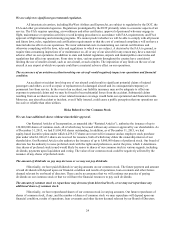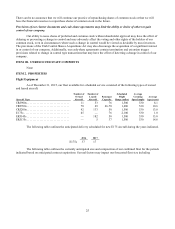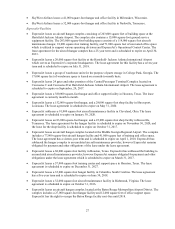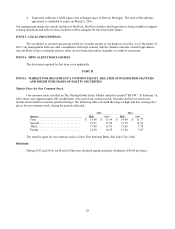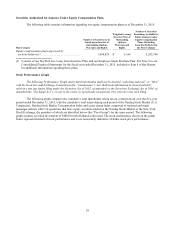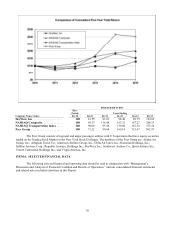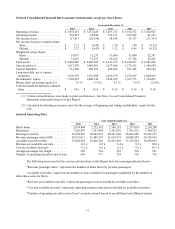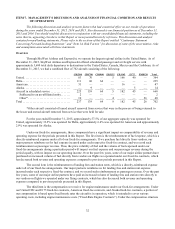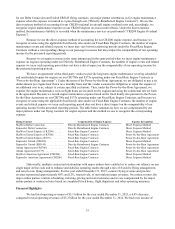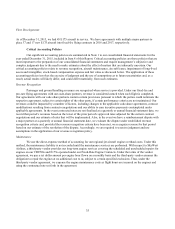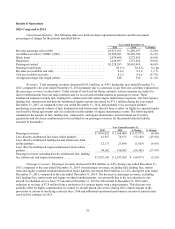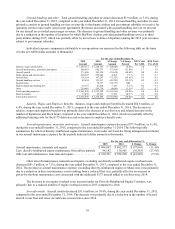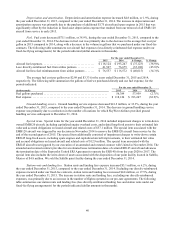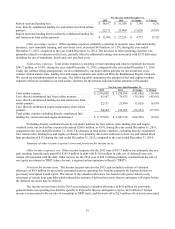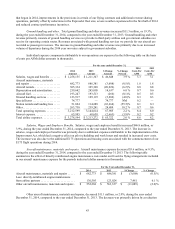SkyWest Airlines 2015 Annual Report Download - page 37
Download and view the complete annual report
Please find page 37 of the 2015 SkyWest Airlines annual report below. You can navigate through the pages in the report by either clicking on the pages listed below, or by using the keyword search tool below to find specific information within the annual report.
33
for our Delta Connection and United ERJ145 flying contracts, our major partner reimburses us for engine maintenance
expense when the expense is incurred as a pass-through cost (“Directly-Reimbursed Engine Contracts”). We use the
direct-expense method of accounting for our CRJ200 regional jet aircraft engine overhaul costs and, accordingly, we
recognize engine maintenance expense on our CRJ200 engines on an as-incurred basis. Under the direct-expense
method, the maintenance liability is recorded when the maintenance services are performed (“CRJ200 Engine Overhaul
Expense”).
Because we use the direct-expense method of accounting for our CRJ200 engine expense, and because we
recognize revenue using the applicable fixed hourly rates under our Fixed-Rate Engine Contracts, the number of engine
maintenance events and related expense we incur may vary between reporting periods under the Fixed-Rate Engine
Contracts without a corresponding change to our passenger revenues that may impact the comparability of our operating
income for the presented reporting periods.
Because we recognize revenue in the same amount and in the same period when we incur engine maintenance
expense on engines operating under our Directly- Reimbursed Engine Contracts, the number of engine events and related
expense we incur each reporting period does not have a direct impact on the comparability of our operating income for
the presented reporting periods.
We have an agreement with a third-party vendor to provide long-term engine maintenance covering scheduled
and unscheduled repairs for engines on our CRJ700s and E175s operating under our Fixed-Rate Engine Contracts (a
“Power-by-the-Hour Agreement”). Under the terms of the Power-by-the-Hour Agreement, we are obligated to pay a set
dollar amount per engine hour flown on a monthly basis and the vendor assumes the obligation to repair the engines at
no additional cost to us, subject to certain specified exclusions. Thus, under the Power-by-the-Hour Agreement, we
expense the engine maintenance costs as flight hours are incurred on the engines and using the contractual rate set forth
in the agreement. Because we record engine maintenance expense based on the fixed hourly rate pursuant to the Power-
by-the-Hour Agreement on our CRJ700s and E175s operating under our Fixed-Rate Engine Contracts, and because we
recognize revenue using the applicable fixed hourly rates under our Fixed-Rate Engine Contracts, the number of engine
events and related expense we incur each reporting period does not have a direct impact on the comparability of our
operating income for the presented reporting periods. The table below summarizes how we are compensated by our
major partners under our flying contracts for engine expense and the method we use to recognize the corresponding
expense.
Flying Contract
Compensation of Engine Expense
Expense Recognition
SkyWest Delta Connection ............. Directly-Reimbursed Engine Contracts Direct Expense Method
ExpressJet Delta Connection ............ Directly-Reimbursed Engine Contracts Direct Expense Method
SkyWest United Express (CRJ200) ....... Fixed-Rate Engine Contracts Direct Expense Method
SkyWest United Express (CRJ700) ....... Fixed-Rate Engine Contracts Power-by-the-Hour Agreement
SkyWest United Express (E175) ......... Fixed-Rate Engine Contracts Power-by-the-Hour Agreement
ExpressJet United (CRJ200) ............ Fixed-Rate Engine Contracts Direct Expense Method
ExpressJet United (ERJ145) ............ Directly-Reimbursed Engine Contracts Power-by-the-Hour Agreement
Alaska Agreement (CRJ700) ............ Fixed-Rate Engine Contracts Power-by-the-Hour Agreement
Alaska Agreement (E175) .............. Fixed-Rate Engine Contracts Power-by-the-Hour Agreement
SkyWest American Agreement (CRJ200) . . Fixed-Rate Engine Contracts Direct Expense Method
ExpressJet American Agreement (CRJ200) . Fixed-Rate Engine Contracts Direct Expense Method
Historically, multiple contractual relationships with major airlines have enabled us to reduce our reliance on any
single major airline code and to enhance and stabilize operating results through a mix of fixed-fee flying arrangements
and our pro-rate flying arrangements. For the year ended December 31, 2015, contract flying revenue and pro-rate
revenue represented approximately 88% and 12%, respectively, of our total passenger revenues. On contract routes, the
major airline partner controls scheduling, ticketing, pricing and seat inventories and we are compensated by the major
airline partner at contracted rates based on completed block hours, flight departures and other operating measures.
Financial Highlights
We had total operating revenues of $3.1 billion for the year ended December 31, 2015, a 4.4% decrease,
compared to total operating revenues of $3.2 billion for the year ended December 31, 2014. We had a net income of



